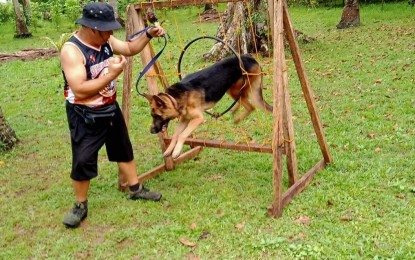
AGILITY TRAINING. Toby, a German shepherd, and his owner/handler Gerry Orosco, are shown during a training on Thursday (April 27, 2023) in Bacacay, Albay. The training is being conducted by the Philippine Coast Guard Auxiliary for 11 hybrid dogs to hone their skills for search and rescue and sniffing of bombs and other explosives as force multipliers. (Photo by Emmanuel Solis)
LEGAZPI CITY – After the successful six-month training by the Philippine Coast Guard Auxiliary (PCGA), 11 hybrid dog breeds have been observed to have gained significant improvement in their skills for search and rescue (S&R) and sniffing of bombs and other explosives.
In an interview during the actual training, Petty Officer 1 Lester Bidar, Chief Master at Arms of the Coast Guard K-9 Field operating unit and in charge of the Narcotic Detection of Dogs in Bicol, said all the dogs have passed the Legazpi City Search and Rescue Detection Dog Organization and Explosive (LESSARDO) training so they could now be considered as effective working dogs for rescue operations in landslides, volcanic eruption and other forms of natural calamities.
“But we will wait for the members of the K-9 force from the office of the PCGA in Manila to visit the training ground on May 5 for their final evaluation of the performances of these dogs that passed the evaluation. If yes, then that is the time for them to be considered as ‘working dogs’ and the owners will be called ‘certified handlers,’" Bidar added.
He said the six-month training started in November last year and it will end on May 12 this year with a formal graduation ceremony for the dogs to be accompanied by their owners and handlers to the district office of PCGA in this city.
Bidar said they conducted the Level 1.1 training or the bonding and discipline with dogs as part of the strategy to make them easy to teach and learn the training.
“We teach them also a Level 1.2 or the ball drive development and Level 2.1 which is the printing or the introduction of substances on how to search hidden illegal drugs as part of the narcotic training,” he added.
In the sniffing of bombs and other explosive training, he said the working dogs should step properly and not dig the exact location of the explosive as part of the measures to make sure that the dogs are safe during operations, noting that there are now some bombs and landmines with sensor fuses.
He said they also trained the dogs to improve their ability to smell even during nighttime or in the dark.
In a separate interview, Officer First Class Arjay Ceneta, instructor for search and rescue operations, said they would hide people in the ground and the dogs would look for them as S&R training for landslides and other calamities.
He said they also teach the handlers for basic life support as well as first aid and how to feed the dogs properly so that these canines would respond in obedience to the command of the handlers during actual operations.
Dr. Emmnauel Estipona, chief of the City Veterinary Office (CVO), in another interview said the LESSARDO training materialized through a memorandum of understanding signed by the city government of Legazpi and the PCGA in October last year which had as theme “Community-Based Disaster Resiliency and Mitigation.
“After this training, we are also planning to train some dogs and pet owners from 70 villages of Legazpi and I will propose to make the old slaughter building become a training center for dogs,” Estipona added.
He said the establishment of the K-9 multiplier force was conceptualized in 2019 when Legazpi City was hit by Typhoon Rolly and the PCG was among the responders to the typhoon victims.
“I decided to organize a LESSARDO because I remembered the tragedy brought by Super Typhoon Reming in 2007, four days after the typhoon a puppy was digging in the ground while the responders observed the puppy and saw one nearly dying survivor on the ground and then the responders automatically rescued the baby girl,” Estipona added.
He said that LESSARDO is part of his advocacy for the proper care and training of dogs to become force multipliers in response efforts during natural calamities.
Legazpi is the first local government unit (LGU) in the country to implement the K-9 program in partnership with the PCGA. (PNA)
